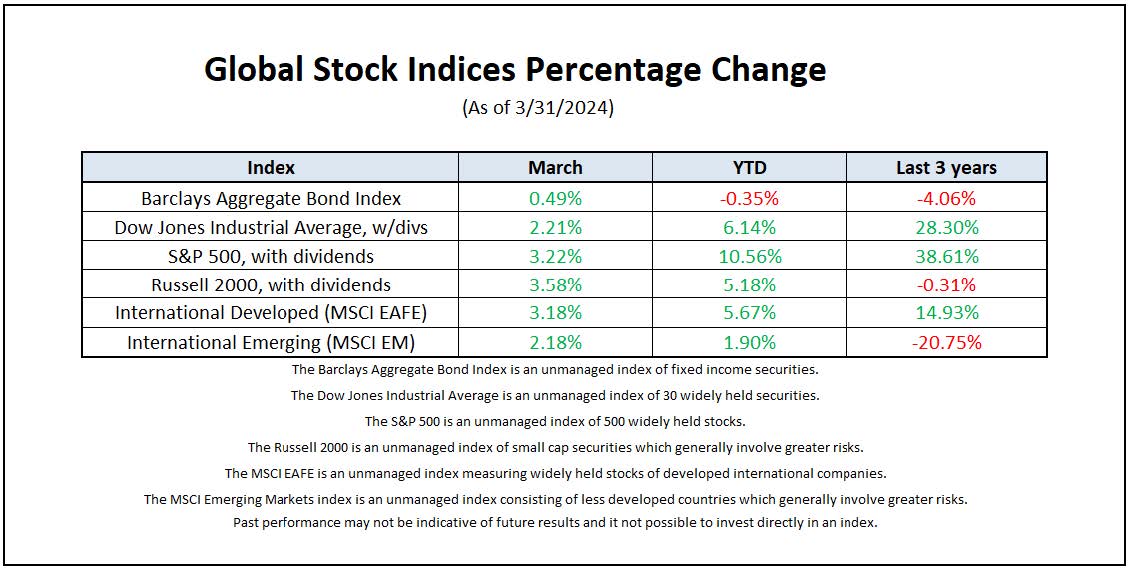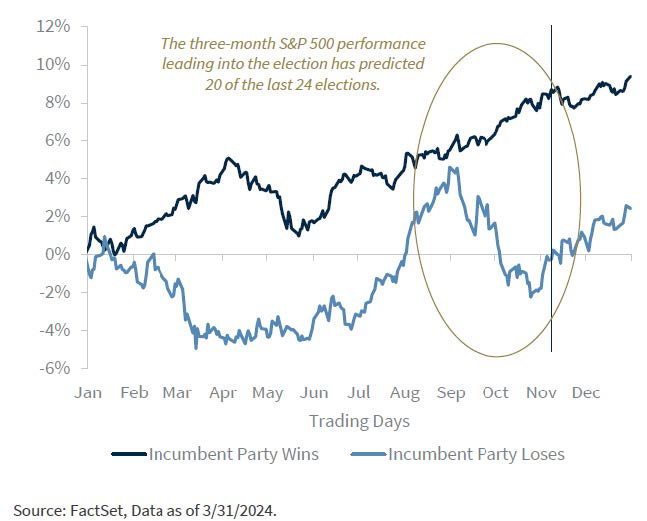
Paul Jesinskis, CFP®
Financial Advisor
“The fact that other people agree or disagree with you makes you neither right or wrong. You will be right if your facts and reasoning are correct.” ~ Peter Bernstein
Prologue
March saw a month of new records, with all three major indices – the S&P 500, Dow Jones Industrial Average, and Nasdaq – reaching all-time highs. This bullish trend persisted for the fifth consecutive month. Despite concerns about interest rates remaining elevated, the stock market demonstrated solid resilience.
While the Mag-7 continued to get much of the attention, only 5 of the 7 companies outperformed the S&P 500 in the first quarter while the other 493 names managed a 6% gain. In another sign that the markets could be broadening out, the Euro Stoxx 50 nearly matched the S&P 500 on a US dollar basis for the first three months.
Bond yields were largely unchanged in March, sitting close to the upper end of their year-to-date range as the March rate cut didn’t materialize and the first rate cut now seems likely to happen later in 2024.
With Q1 2024 in the books the S&P 500 is up 10% year-to-date. The main reason (and driving force) has been the economy. 2023 real GDP finished at 2.5% y/y, and 2024 GDP estimates have increased to 2.2% on top of that growth (despite virtually every economist – including the Fed – believing we would be in recession).
The equity market’s strong start likely increases the likelihood of near-term volatility. It typically experiences three to four pullbacks of 5% or more each year and hasn’t had one since September 2023.
Please reach out with questions.
-Paul
Noteworthy links:
- The Market, Larry McDonald: We’re About to Witness a Historic Migration of Capital
- Raymond James: RMD rules delayed for inherited IRAs...again?
- Raymond James: Investment Strategy Quarterly

Chart of the Month
Three-month Equity Performance Leading into Election a Solid Predictor

Article of the Month
Don't give in to inflation panic
Dealing with inflation and a bear market as you near retirement.
It’s hard to see your portfolio dip and not panic – especially as you near retirement. Coupled with record inflation, a dip might tempt you to sell your investments to drive cash flow. But long-term thinking even when nearing retirement is the key to preventing portfolio erosion, and to achieving much more.
Avoid this pitfall by taking a holistic approach to your finances and enlisting help from your advisor. Here are some dos and don’ts for dealing with inflation and a bear market as you near retirement.
Do get a clear picture of where you stand. First and foremost, it’s important to tune out the panic-inducing headlines and revisit your personal situation and current position. This is best done with your advisor, who can hear your concerns and offer a level-headed approach and make necessary adjustments if needed.
Don’t bail out at the bottom of a dip. Realize selling everything now would cement a loss and wouldn’t allow you the opportunity to recover when the market picks back up again. While there may be some instances where it makes sense to cut your losses (probably fewer than you think), this should not be a widespread strategy in a downturn.
Do consider using cash from other sources if you’re able. It’s wise to have cash to cover up to 12 months of expenses in retirement, and while this doesn’t always provide enough time for your portfolio to fully bounce back, it provides a cushion and gives you time to determine the best next steps. One strategy involves selling less volatile bonds in order to generate cash, even though it might seem counterintuitive. It will buy time for more active investments to come back.
Don’t write off working a little longer. Whether full-time or part-time, working longer can give your investments time to recover. (Bonus: Working part-time may make for an easier emotional transition into retirement.) If you’re already retired, going back to work might not sound so appealing. Instead, consider reducing expenses and sticking to a stricter budget for now.
Do speak to your advisor about your concerns. Trust the relationship you’ve built with your advisor. They have your best interest at heart. You may consider rebalancing your portfolio a bit, but only after taking a holistic look and conducting your due diligence. Remember, you diversified accordingly as you were saving for retirement, and while the market has shifted, you don’t need to overhaul your portfolio to account for these changes.
Take your emotions out of the equation when it comes to investment decisions in a fluctuating market. This will help you fare better as you near your retirement date. A long-term lens will keep market ups and downs in perspective and let you focus on the exciting time retirement should be.
If you’re retiring in this market,
- Avoid making any emotional, rash decisions regarding your investments
- Discuss concerns with your advisor, who can make recommendations based on your situation
Past performance may not be indicative of future results. There is no assurance any investment strategy will be successful. Investing involves risk including the possible loss of capital. Diversification does not guarantee a profit nor protect against loss. The process of rebalancing may result in tax consequences.
Here is a link to the full article: Don't give in to inflation panic
*Raymond James & Associates, Inc, member New York Stock Exchange/SIPC
*The information contained in this report does not purport to be a complete description of the securities, markets, or developments referred to in this material, and is not a recommendation. There is no guarantee that these statements, opinions or forecasts provided herein will prove to be correct.
*Views expressed are the current opinion of the author, but not necessarily those of Raymond James. The author’s opinions and forward looking statements expressed are subject to change without notice. This information does not constitute a solicitation or an offer to buy or sell any security. Information contained in this report was received from sources believed to be reliable, but accuracy is not guaranteed.
*There is no assurance any investment strategy will be successful. Investing involves risk and you may incur a profit or loss regardless of strategy selected, including diversification and asset allocation. Past performance may not be indicative of future results. International investing involves additional risks such as currency fluctuations, differing financial accounting standards, and possible political and economic instability. These risks are greater in emerging markets. Small- and mid-cap securities generally involve greater risks and are not suitable for all investors. Asset allocation and diversification do not guarantee a profit nor protect against a loss. Individual investor’s results will vary.
*Gross Domestic Product (GDP) is the annual market value of all goods and services produced domestically by the U.S. Past performances are not indicative of future results. Investing always involves risk and you may incur a profit or loss. No investment strategy can guarantee success.
*This information contains forward-looking statements about various economic trends and strategies. You are cautioned that such forward-looking statements are subject to significant business, economic and competitive uncertainties and actual results could be materially different. There are no guarantees associated with any forecast and the opinions stated here are subject to change at any time and are the opinion of the individual strategist. Data comes from the following sources: Census Bureau, Bureau of Labor Statistics, Bureau of Economic Analysis, the Federal Reserve Board, and Haver Analytics. Data is taken from sources generally believed to be reliable but no guarantee is given to its accuracy.
*Links are being provided for information purposes only. Raymond James is not affiliated with and does not endorse, authorize, or sponsor any of the listed websites or their respective sponsors. Raymond James is not responsible for the content of any web site or the collection or use of information regarding any web site’s users and or/members.
*Certified Financial Planner Board of Standards Inc. owns the certification marks CFP®, CERTIFIED FINANCIAL PLANNER™ and Federally registered CFP (with flame design) in the U.S., which it awards to individuals who successfully complete CFP Board’s Initial and ongoing certification requirements.
*The S&P 500 is an unmanaged index of 500 widely held stocks that is generally considered representative of the U.S. stock market.
*To opt out of receiving future emails from us, please reply to this email with the word “Unsubscribe” in the subject line. The information contained within this commercial email has been obtained from sources considered reliable, but we do not guarantee the foregoing material is accurate or complete.
Insights & Discovery